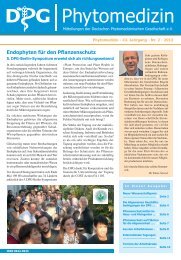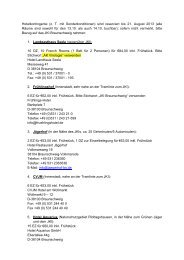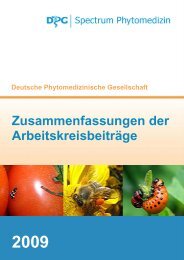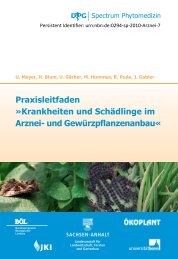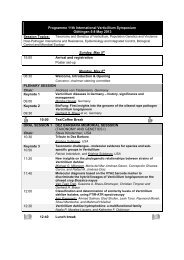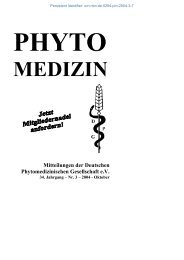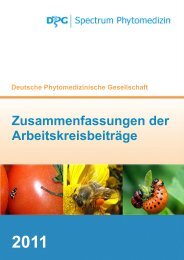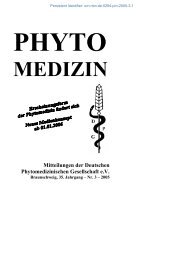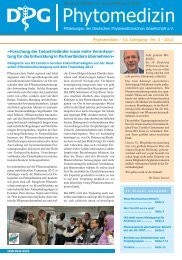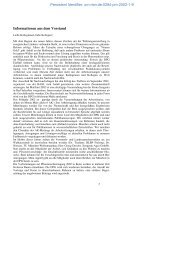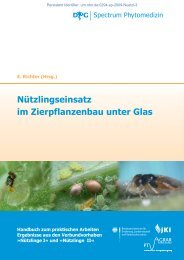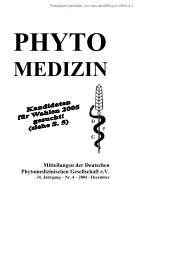fourth joint meeting of dutch and german
fourth joint meeting of dutch and german
fourth joint meeting of dutch and german
Create successful ePaper yourself
Turn your PDF publications into a flip-book with our unique Google optimized e-Paper software.
Single-chain antibodies against a plant viral RNA-dependent RNA polymerase confer virus<br />
resistance<br />
K Boonrod 1 , D Galetzka 1,2 , PD Nagy 3 , U Conrad 4 <strong>and</strong> G Krczal 1<br />
1 Centrum Grüne Gentechnik, RLP AgroScience GmbH, Neustadt, 2 Klinikum der Johannes<br />
Gutenberg Universität Mainz, Institut für Humangenetik, Mainz, 3 Department <strong>of</strong> Plant Pathology,<br />
University <strong>of</strong> Kentucky, Lexington, USA <strong>and</strong> 4 Institute <strong>of</strong> Plant Genetics <strong>and</strong> Crop Research<br />
Gatersleben (IPK), Gatersleben<br />
E-mail: gabi.krczal@dlr.rlp.de<br />
Crop loss due to viral diseases is still a major problem for agriculture today. We present a strategy<br />
to achieve virus resistance based on the expression <strong>of</strong> single-chain Fv fragments (scFvs) against a<br />
conserved domain in a plant viral RNA-dependent RNA polymerase (RdRp), a key enzyme in virus<br />
replication. The selected scFvs inhibited complementary RNA synthesis <strong>of</strong> different plant virus<br />
RdRps in vitro <strong>and</strong> virus replication in planta. Moreover, the scFvs also bound to the RdRp <strong>of</strong> the<br />
distantly related hepatitis C virus. T1 <strong>and</strong> T2 progeny <strong>of</strong> transgenic lines <strong>of</strong> Nicotiana benthamiana<br />
expressing different scFvs either in the cytosol or in the endoplasmic reticulum showed varying<br />
degrees <strong>of</strong> resistance against four plant viruses from different genera, three <strong>of</strong> which belong to the<br />
Tombusviridae family. Virus resistance based on antibodies to RdRps adds another tool to the<br />
repertoire for combating plant viruses.<br />
Translocation <strong>and</strong> immunolocalisation <strong>of</strong> Watermelon chlorotic stunt virus, WmCSV, in its<br />
vector Bemisia tabaci (Genn.)<br />
I Fahmy Farouk 1 , D-E Lesemann 2 <strong>and</strong> S Winter 1<br />
1 2<br />
DSMZ Plant Virus Division, Braunschweig <strong>and</strong> BBA, Dept. <strong>of</strong> Plant Virology, Microbiology <strong>and</strong><br />
Biosafety, Braunschweig<br />
E-mail: s.winter@bba.de<br />
To investigate the mechanisms <strong>of</strong> begomovirus transmission by Bemisia tabaci, acquisition <strong>and</strong><br />
translocation <strong>of</strong> Watermelon chlorotic stunt virus, WmCSV, in the insect was studied. A whitefly<br />
transmissible WmCSV isolate from Sudan <strong>and</strong> 4 non transmissible mutants carrying a single amino<br />
acid mutation in the core region <strong>of</strong> the capsid protein were used for the translocation experiments.<br />
B. tabaci fed on virus infected watermelon plants were transferred to non host plants for virus<br />
discharge <strong>and</strong> subsequently used to infect watermelons. Transmission was taken as evidence for a<br />
functional interaction between virions, the gut membrane <strong>and</strong> the primary or accessory salivary<br />
gl<strong>and</strong>s. Fresh, dissected organs from viruliferous whiteflies feeding on wild type or mutant virus<br />
were examined by PCR to determine the presence <strong>of</strong> virus. WmCSV was detected in the midgut,<br />
hemocoel <strong>and</strong> salivary gl<strong>and</strong>s <strong>of</strong> B. tabaci for the transmissible <strong>and</strong> the non transmissible virus<br />
mutants. However, in Trialeurodes vaporariorum (a non vector <strong>of</strong> geminiviruses), wild-type<br />
WmCSV was detected in the midgut only, thus suggesting that the virus was not capable <strong>of</strong><br />
crossing the gut wall. In contrast, in B. tabaci, the accessory <strong>and</strong>/or the primary salivary gl<strong>and</strong>s<br />
apparently present the significant epithelial barrier to virus transmission. Hence, for the<br />
begomovirus WmCSV <strong>and</strong> its whitefly vector, a pathway similar to the luteovirus / aphid<br />
translocation is expected. In immunolocalization studies with organs excised from viruliferous<br />
insects carrying wild type or non transmissible virus mutants, a specific labelling with WmCSV<br />
antiserum was obtained at the microvilli region <strong>of</strong> the epithelial cells <strong>of</strong> the gut wall food canal,<br />
indicating for putative virus adsorption sites or, for a putative receptor-mediated delivery to the<br />
hemoceol. Respective experiments carried out with primary <strong>and</strong> accessory salivary gl<strong>and</strong>s so far<br />
did not indicate for specific adhesion/entry sites into these organs.<br />
14



